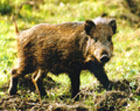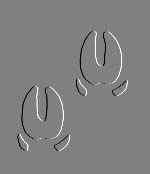WILD BOAR (PIG)
(Sus scrofa)
|

Enlarge Photo

Tracks
Listen To It!

Squeeler
14k
|
Mass: 110 - 770 kg
Length: to 6 ft. (1.8 m)
Biomes: tropical deciduous forest,tropical rainforest,tropical scrub forest,temperate forest and rainforest,chaparral
Status: no special status. Similar to dogs, the breeds of Sus scrofa are virtually countless. Overall Sus scrofa is not threatened by extinction, though some particular breeds are more at risk than others.
Range: Of all the pigs in the pig family, Sus scrofa occupies the largest range. They originally dwelt in Europe, Asia, North Africa, and the Malay Archipelago and were later scattered across the world as objects of trade. Sus scrofa has been reared as farm animals since their domestication process began five thousand years ago. Sus scrofa can be found nearly everywhere, from homes to barns to boggy marshes and mountainous terrain.
Hiker's Note:
Over the past 40 million years Sus scrofa has developed varying skin color, bone structure, tail length, snout
shape, and more in response to the smorgasbord of environments they have inhabited. Yet, all Sus scrofa are ungulates, making them immediately identifiable by their distinct toe shape. Ungulates have retained their two largest toes while the other toes have decreased in size or disappeared. It is believed that Sus scrofa lack good eyesight. The eyes are positioned on the sides of the head, which hinders Sus scrofa from staring straight ahead. Sus scrofa has varying ear shapes, ranging from small and erect to low-flapping. (Hopf, 1979; vanLoon, 1979)
In ancient Egypt, Sus scrofa was used for "treading the seed." Their hoofs created holes perfect in size and depth for planting seeds. The Egyptians exploited this ability and used Sus scrofa extensively during planting seasons. Their tracks are 2 - 3 in. (5 - 7 cm.) long with very prominent, widely spaced, dew claws.
References
|


